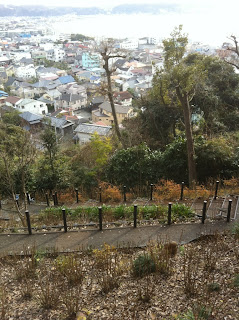Legend has it that the statue housed here (photos of the statue are not allowed) was one of two large carvings from a single camphor tree. This one was cast into the sea, with the hope that it would lead those who found it to faith and hope. It washed up after 15 years near here, and was brought to this site, where a temple was built to house it.
The temple has a large garden, planted Japanese style with seasonally blooming plants - in the winter, there are Japanese plum, camelia, witch hazel, narcissus, and yellow plum in view. I spent quite a bit of time enjoying these spaces, including the water gardens at the bottom of the hill, and the "Prospect Road" trail along the top.
Other features of this holy place were a number of smaller shrines, a bell tower, a library where the sutras (holy texts) are kept, a vegetarion restaurant, grottoes, and an observation platform that looks out over the town to the Pacific Ocean. I've included a couple of photos below of one of the outdoor spaces along the Prospect Road, where there was a small enclave against the hill with a number of statues.
The primary statue here dates to 721 AD, and had gold leaf applied in 1342. Other statues here date to 1193 and 1412. It is still an active holy place, as were several sites that I visited on my touring day, and new monuments and shrines are constantly being added to the temple. There is a museum here, which I didn't visit because of my schedule, but this features cultural items such as scrolls, hanging mirrors, and a collection of 33 incarnations of the cannon.
Closing out with a final photograph of the Buddha's footprint. There is a tradition that the first Buddha left footprints on a stone in India, which marked a physical presence before the enlightenment. At this temple, this sign was on a platform near where the Kannon was housed.
My next stop was Daibutsu, the giant Buddha of Kamakura. I'll post about that tomorrow.







No comments:
Post a Comment